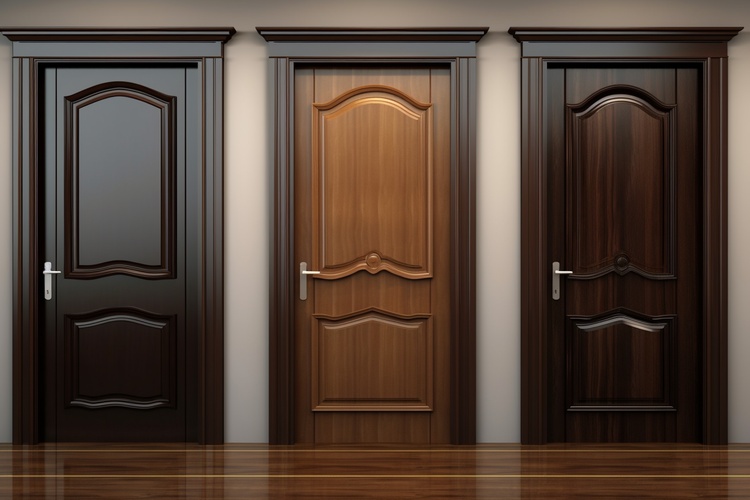Enhance Your Home's Kerb Appeal: A Guide to Choosing the Perfect Front Door
Your front door is more than just an entrance; it’s a statement that defines your home’s character and provides the first line of defence against the elements and intruders. With a huge range of materials, styles, and colours available, finding the right one can feel overwhelming. This article simplifies the process by exploring the key factors to consider, from security features and energy efficiency to the aesthetic that best complements your property. Discover the pros and cons of popular door materials like composite, uPVC, and timber, helping you make an informed choice that enhances your home’s look and value for years to come.

What are the essential front door security features?
When it comes to protecting your home, your front door is your first line of defence. Modern doors come equipped with a range of security features designed to deter intruders and provide peace of mind. Look for doors with multi-point locking systems, which secure the door at various points along the frame, making it much harder to force open. Reinforced strike plates and high-quality deadbolts are also crucial components of a secure front door.
For added security, consider doors with laminated or toughened glass panels, which are more resistant to breaking. Some manufacturers offer doors with built-in smart technology, allowing you to monitor and control access remotely. Remember, the frame is just as important as the door itself, so ensure it’s made of sturdy materials and properly installed to withstand forced entry attempts.
How to match your front door to your home’s style?
Choosing a front door that complements your home’s architectural style is key to enhancing its kerb appeal. For traditional homes, consider classic wooden doors with panelled designs or decorative glass inserts. Victorian and Edwardian properties often suit doors with ornate details and vibrant colours like deep reds or blues.
Modern and contemporary homes benefit from sleek, minimalist designs. Opt for doors with clean lines and materials like aluminium or composite with a smooth finish. Large glass panels can create a striking entrance while allowing natural light to flood your hallway.
Don’t be afraid to make a statement with colour. While neutral tones like white, black, or natural wood finishes are timeless, bold hues can add personality and make your home stand out. Just ensure the colour you choose harmonises with your home’s exterior palette and surrounding landscape.
Understanding front door energy efficiency
Energy efficiency is a crucial factor in choosing a front door, impacting both your home’s comfort and your energy bills. Look for doors with a high energy rating, indicated by their U-value – the lower the U-value, the better the insulation properties.
Composite doors are known for their excellent thermal performance, often featuring a foam core that provides superior insulation. uPVC doors are also a popular choice for their energy-efficient properties and low maintenance requirements.
Pay attention to weatherstripping and threshold design. A well-sealed door prevents drafts and heat loss, contributing significantly to your home’s overall energy efficiency. Some doors come with adjustable thresholds, allowing you to maintain a tight seal even as the door settles over time.
What are the benefits of a composite front door?
Composite doors have gained popularity in recent years, and for good reason. These doors combine the best qualities of various materials to create a product that excels in durability, security, and aesthetics. The core is typically made of an insulating foam material, surrounded by a sturdy frame and finished with a weather-resistant GRP (Glass Reinforced Plastic) skin.
One of the main advantages of composite doors is their low maintenance requirements. Unlike wood, they don’t need regular painting or staining and are resistant to warping, swelling, and cracking. This makes them an ideal choice for homeowners looking for a long-lasting, hassle-free option.
Composite doors also offer excellent thermal efficiency, helping to keep your home warm in winter and cool in summer. Their robust construction provides enhanced security, and they come in a wide range of styles and colours to suit any home design.
How do different door materials compare in performance and cost?
When selecting a front door, it’s essential to consider the performance and cost of different materials. Here’s a comparison of popular door materials to help you make an informed decision:
| Material | Durability | Energy Efficiency | Security | Cost Estimation |
|---|---|---|---|---|
| Composite | High | Excellent | High | £800 - £2,000 |
| uPVC | Medium | Good | Medium | £500 - £1,200 |
| Timber | Medium-High | Good | Medium-High | £600 - £2,500 |
| Aluminium | High | Good | High | £1,000 - £3,000 |
Prices, rates, or cost estimates mentioned in this article are based on the latest available information but may change over time. Independent research is advised before making financial decisions.
Composite doors offer the best all-around performance but come at a higher price point. uPVC doors are a more budget-friendly option with good energy efficiency, while timber doors provide classic aesthetics but may require more maintenance. Aluminium doors are known for their strength and sleek appearance but are typically the most expensive option.
Conclusion
Choosing the perfect front door involves balancing aesthetics, security, energy efficiency, and budget. By considering the essential security features, matching the door to your home’s style, understanding energy efficiency ratings, and weighing the benefits of different materials like composite doors, you can make a choice that not only enhances your home’s kerb appeal but also provides long-lasting value and protection. Remember to consider both the upfront costs and long-term benefits when making your decision, ensuring your new front door serves you well for years to come.




